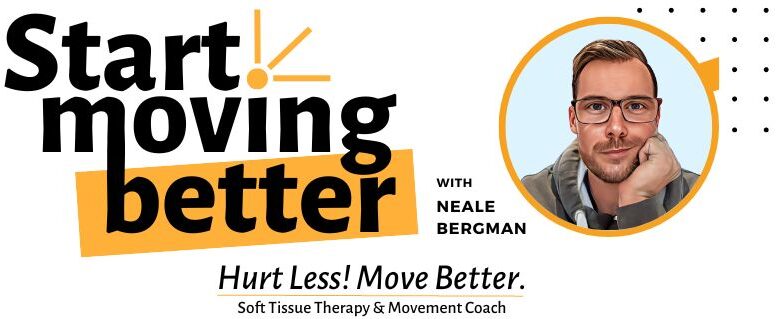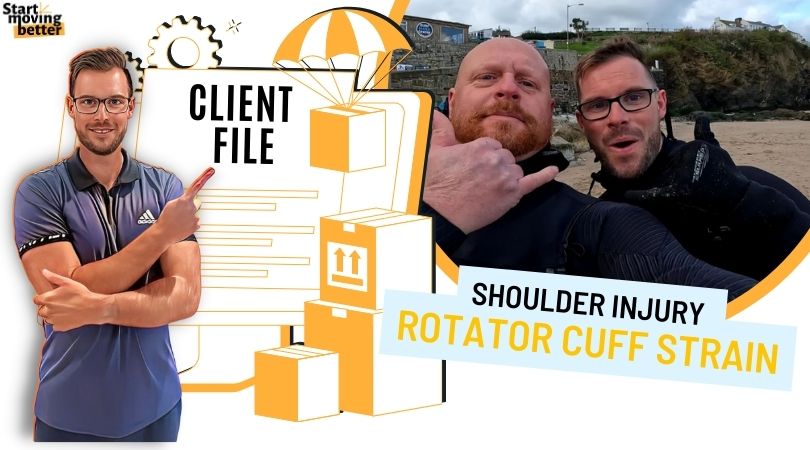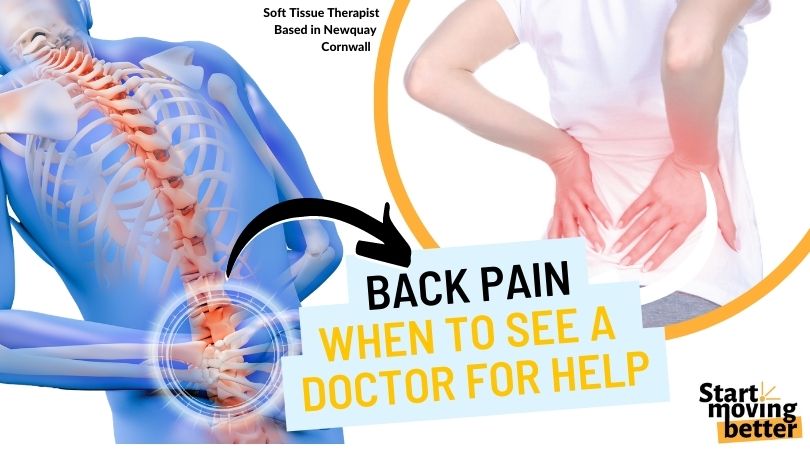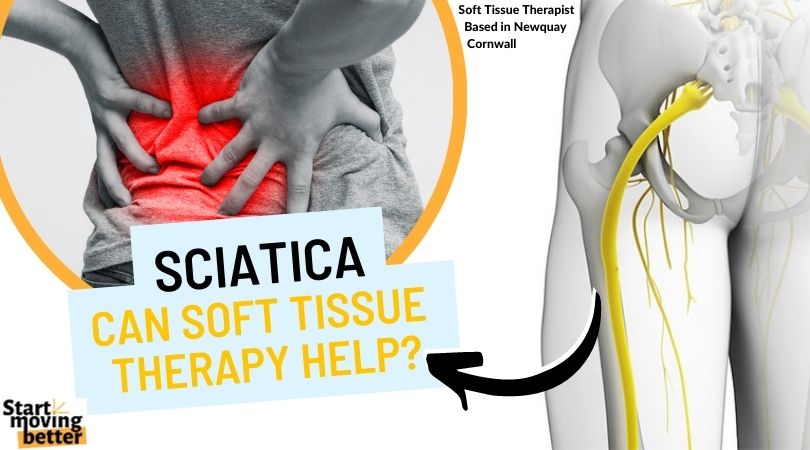In today’s client file, we’ll explore a Rotator Cuff Strain that a recent client experienced.
Before we deep dive into today’s client file. I want to reassure you I gained full permission from my client to share his story. In fact, I sent him this blog before it went live. He could change anything about it and close the whole file down if he wasn’t OK with it.
With that said… let’s jump in.
Neil’s Rotator Cuff Strain
Neil came to me with a rotator cuff strain on the left side. The rotator cuff muscles are a group of four muscles. They all originate from the scapula (shoulder blade) and attach to the humerus (upper arm bone). These muscles work together to stabilize the shoulder joint. They allow for rotation and movement of the arm.
Every movement of the shoulder, and the rotator cuff muscles are in play at some point. They are 100% vital to every shoulder movement.
We’ll deep dive into these four muscles shortly and explore Neils’s injury. Before then, let’s find out more about Neil.
What caused Neil’s Rotator Cuff Strain?
In the weeks previous Neil had surfed and mountain biked several times. At some point, Neil took a blow or trauma to the shoulder. It’s hard to time stamp specifically what movement or activity caused it. But a rotator cuff strain doesn’t just happen. Some kind of trauma must have happened.
Neil found it hard to sleep on his left side which over time disrupted his sleep. As we all know, when we are tired day to day life becomes tougher again.
Neil has an active job and found his left arm/shoulder became a big hindrance. Lifting his arm up and out to the side wasn’t easy let alone weight-bearing the arm at work.
In a short space of time daily output and activity declined. Surfing and mountain biking was knocked on the head. And general daily chores became harder.
Now then… Neil took action quite quickly, to be honest. But I have worked with some clients who they’ve tolerated their pain for far too long. And with a decrease in activity, poor sleep, and avoidance of making the pain worse… it’s not long before it affects their mental state.
It’s more than just fixing a muscle. The ripple effect of not taking action affects many more areas of our body and brain.
Getting Help
I digress… Neil took over-the-counter painkillers (ibuprofen) as and when needed. He also contacted his GP for guidance. Following a short GP call the wait for a face-to-face visit was some 6 weeks. The GP informed Neil it might be a rotator cuff strain.
Anyhoo…
The next day Neil contacted me. We had a short discussion to make sure I could help which I could. I met with Neil the next evening in the clinic. I spent the first 15 minutes asking questions and completing a few functional tests.
These functional tests allow us to discover what you can and can’t do. Every muscle and joint in the body has an optimal state or range of movement. We experience pain or discomfort because a joint or muscle is not in its optimal state.
In Neil’s case, we had to find out which muscle and/or rotator cuff muscle wasn’t particularly happy. Within 10 minutes it was clear the Supraspinatus was the culprit.
Rotator Cuff Strain: The Supraspinatus
Out of the four rotator cuff muscles, the supraspinatus is the most common and most prone to injury. Its primary function is to assist with abduction (lifting away from the body).
Said differently, lifting the arm away from the body at the shoulder joint. When you raise your arm to the side, the supraspinatus muscle contracts. It helps to stabilise the head of the humerus (upper arm bone) in the shoulder socket.
Ultimately these muscles help maintain proper shoulder mechanics and prevent injury.
As soon as the supraspinatus (or any muscles for that matter) is injured, you’ll experience:
- Discomfort
- Pain
- Weakness
- Decreased range of movement
- Referred pain to another muscle or joint
- Decreased strength in that area
- Compensated movements
- Poor posture
- Fear-avoidance
- Shielding the injured area
Now then.
A rotator cuff strain isn’t going to repair itself. Nor is it going to miraculously be better in a week or twos time. Leaving it to recover on its own leads to one thing.
More discomfort.
Lol. I digressed again… but hopefully, it’s useful information?
Neil’s First Soft Tissue Therapy Session
Following the functional test, we got right into the main therapy session. I spent a few minutes on the non-injured side. This is important as it gives me an opportunity to feel the tissue that’s not affected. I can then make a sound comparison to the affected side.
We spent most of the first session focusing on the periscapular muscles. These are the muscles that surround the scapula (shoulder blade). They also help to stabilize and move the shoulder joint.
In fact, very little work was directed toward the supraspinatus. At the end of the day, this muscle was still very painful and inflamed. It was evident the periscapular muscles were overworking to compensate for the supraspinatus. In particular the Trapezius, Rhomboids, and Serratus anterior.
I used a variety of soft tissue therapy techniques on these muscles. Within 30 minutes Neil gained a greater range of movement in his shoulder. What’s more, he could noticeably feel the difference and reported less discomfort. To be honest I think Neil was shocked at just how much movement was gained in the shoulder in such as short time frame.
How Does Soft Tissue Therapy Help Muscle Strains?
The idea of soft tissue therapy is to politely stress a muscle enough so it relaxes. Once a muscle is relaxed it can refind its optimal place and center. Each therapy technique is implemented for this very reason.
Each and every movement, the amount of pressure, the sequence, and the order are key to a result taking place. Whilst it might feel relaxing and a random array of hands-on techniques I can assure you it’s not random.
At the end of the session, I gave Neil some basic movements to complete and home-care advice. This meant he kept the gains made from our session. I also bugged Neil (lol) via Whatsapp most days to make sure he was doing the exercises.
We all know what to do… but we need accountability to do them.
That’s where I come in. I’m not there just for a 60-minute appointment. I’m here to ensure you hurt less and move better!
Neil came back weekly for 3 more visits. Each time Neil came back his shoulder was making great progress. With less inflammation, more strength, and a greater range of movement.
In the second session, we focused our attention on the shoulder and neck muscles. Again these muscles support the rotator cuff muscles.
In the third session, we focused on the mid and lower back. Even these muscles much lower down compensate for the body when the shoulder is out.
Toward the end of the third session and the fourth session, we focused on the rotator cuff muscles.
Today’s Key Takeaway
You may have an ache or pain in a specific muscle. And at times we go straight to the muscle in pain. But all too often, we’ll find ourselves exploring the other muscles around the pain. These other muscles require equal if not more attention than the injured site itself.
To finish up, Neil was back in the surf on Boxing Day with little to no pain having had just 4 sessions. Neil now sees me once a month to ensure he is on the right track and remains injury free.
I hope you’ve enjoyed today’s client file.
Let’s thank Neil for trusting me and allowing me to help him hurt less and move better.
If you are in pain at the moment and the above client file has helped you move closer toward getting help? Your next step for me to help you be pain-free is to book a FREE consultation.
We can jump on a 10-15 minute phone call. I can ask you about your current pains and discomfort. You can ask me any questions.
At the very least you’ll leave the call with clarity on how to hurt less and move better.
If I feel I can help you in the clinic, we’ll get you booked for your first session.
I look forward to hearing from you
Neale – Soft Tissue Therapist based in Newquay, Cornwall.
To help you right now here are 2 actions to help you become pain-free.
1. Book a free consultation here.
We can arrange a short phone call to see how I can help you.
2. Read this blog: When to see a doctor for back pain – READ NOW
Looking forward to getting you pain-free



